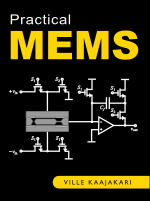 Micromechanical resonators or microresonators have a limit to the
maximum usable vibration amplitude. This limit may be set by material
strength, or as is often case for a MEMS resonator, by unwanted
nonlinear effects. Figure 1 shows how the microresonator resonance
response is changed in the presence of nonlinear restoring forces
(=nonlinear springs). As the vibration amplitude increases, the
resonance peak frequency shifts from the linear resonance
frequency. This is often referred to as the Duffing effect. At
sufficiently large amplitudes, the amplitude-frequency curve shows
hysteresis; the vibration amplitude depends on the direction of
frequency sweep (up/down).
Although there has been some ideas of
taking advantage of nonlinear effects (e.g parametric excitation),
usually the devices need to be operated below the hysteresis point in
order to obtain predictable performance. Translated to electrical
engineering terms, the drive level (or power handling capacity) of
MEMS devices is limited by the nonlinear effects. As the signals
levels from microresonators are small in general, it is of fundamental
interest to know the maximum achievable drive level for micro-sized
devices. This determines, for example, whether one can make a MEMS
oscillator with small enough phase noise for reference
applications.
Micromechanical resonators or microresonators have a limit to the
maximum usable vibration amplitude. This limit may be set by material
strength, or as is often case for a MEMS resonator, by unwanted
nonlinear effects. Figure 1 shows how the microresonator resonance
response is changed in the presence of nonlinear restoring forces
(=nonlinear springs). As the vibration amplitude increases, the
resonance peak frequency shifts from the linear resonance
frequency. This is often referred to as the Duffing effect. At
sufficiently large amplitudes, the amplitude-frequency curve shows
hysteresis; the vibration amplitude depends on the direction of
frequency sweep (up/down).
Although there has been some ideas of
taking advantage of nonlinear effects (e.g parametric excitation),
usually the devices need to be operated below the hysteresis point in
order to obtain predictable performance. Translated to electrical
engineering terms, the drive level (or power handling capacity) of
MEMS devices is limited by the nonlinear effects. As the signals
levels from microresonators are small in general, it is of fundamental
interest to know the maximum achievable drive level for micro-sized
devices. This determines, for example, whether one can make a MEMS
oscillator with small enough phase noise for reference
applications.
The nonlinearities can be of either
mechanical or electrical origin. Most fundamentally, the MEMS
materials are nonlinear due nonlinearities in atomic
interactions. Luckily, silicon is quite linear material and other
nonlinear effects typically dominate. For further information on
nonlinear vibrations and nonlinear effects in MEMS resonators in
particular, please refer to the publications.
